-

人教版新目标初中英语七年级下册I want to be an actor教案2篇
三、教学建议第一课时:1. Lead in (Vocabulary)A) Before class, teacher should collect some pictures of working places. For example: Bank, TV Station, Restaurant, Police Station, Hospital ...B) In class, show students the pictures (PowerPoint, OHP). Ask students to tell the name of the working places and the name of the jobs.Shop assistant, doctor, actor, reporter, police office, waiter, bank clerk, studentC) Do exercise 1a and 3a.2. Bingo GameAsk groups of students to make up pairs of cards with a job on one and the related workplace on the other. For example, waiter / restaurant, teacher / school, doctor / hospital. Encourage students to use both the job / workplace combinations in the book and the ones that students came up during class discussions. Be sure they have twice as many sets of cards as there are students in the group. They can make two sets of cards for a single job / workplace, if necessary. Then have each group mix up its set of cards and hand their cards out in random order. Each time a student gets a pair of cards that match, he or she can lay these cards down. The goal is to have no cards in your hand at the end.3. Task OneA) Ask students to work in pairs and ask the partner what does he / she want to be in the future.e. g. :What do you / does he / does she want to be?I want to be a.Why?Because it's (adj).B) Vocabulary: Section B, 1a4. Homework 1.2.

人教版新目标初中英语七年级下册What do you think of game shows教案
五、教学Section B-2c1. Pair work: What do you think of the belt/sunglasses/…? What does your father/mother/… think of your scarf/belt…?2. Group work(1). Teacher shows some different kinds of school uniforms (制服)and asks : “ What do you think of your school uniforms? If you have a chance to choose your school uniforms, what kind would you like to choose?”(2). Discuss in groups.(3).Get some Ss to report in class.说明:这一步旨在让学生运用已有的语言知识谈论对事物的看法和意见,并简单阐明理由,培养学生的主动思维能力和运用英语的能力。六、教学拓展调查电视节目的收视率任务:调查你周围的人对现在各种电视节目的反响。活动过程:1.教师布置任务,让学生调查周围的人(包括他的亲戚朋友和邻居)喜欢收看哪方面的电视节目。2.学生进行调查活动,运用本单元所学的句型What do you think of….? (Why?)What's your favorite game shows?What do you think of talk show?I doesn’t mind it.I like it.I love it.I can’t stand it.3.记录下排在前10位的TV Program,填写调查表,比较其收视率。

人教版新目标初中英语七年级下册Where did you go on vacation教案
句型: Where did you go on vacation? I went to summer camp.Did she go to Central Park?Yes,she did.No, she didn’t语法:一般过去时特殊疑问句、一般疑问句及肯、否定回答。课时安排4课时第一课时:Section A:la,1b,lc,2a,2b,2c 第二课时:Section A:3a,3b,4第三课时:Section B:1,2a,2b,2c第四课时:Section B:3a,3b,3c,4 and Self Check第一课时教学目标掌握描写假期生活的形容词。假期里自己所做事情的简单表达。谈论假期做的事情及当时情况。谈论假期时旅游的天气,旅游者以及食物等。教学过程一、导入播放一首英文歌曲:Let’s travel 说明:通过让学生听节奏欢快迪斯尼英语歌曲Let’s travel.引入本节课谈论的话题vacation and travel. 让歌曲使学生的思维活跃,增强课堂气氛,激发学生提高学习英语的兴趣。T:How is the trip ?Ss : It’s pretty good/ happy/exciting /relaxing/busy/dangerous/ fantastic说明:这个问题是为了操练形容词。建议让多个Ss作答。鼓励他们用不同的形容词。上述个别形容词本应在第二课时中出现,但可以在warming-up中第一次非正式出现。这些形容词也可在老师的评价语中适时出现,以加深学生对词汇的印象。

人教版新目标初中英语八年级下册If you go to the party, you’ll have a great time教案2篇
区分宾语从句、定于从句和状语从句宾语从句和状语从句,都叫做主从复合句。宾语从句主要是中考必考的,是初中阶段必掌握的从句,宾语从句主要是掌握三要素,所谓宾语从句,就是宾语在主从复合句当中充当宾语的一个句子,叫做宾语从句。主句的谓语动词是及物动词,后面如果是词或者是短语的话,是简单句,如果是句子的话,肯定是宾语从句。I know that he good at English.就是宾语从句,三要素,一要素是要注意连词,连词一共学了三类连词,一类连词是that口语当中可以省略,就像刚才说的那一句,I hear he is good at English.还有疑问代词、疑问副词,how where when,疑问代词、疑问副词。还有一类连词weather是否的意思,不是状语从句当中的如果,这一定要和如果区分开,这是是否。I don't know if he interested at English。宾语从句要注意if是连词。第二要素是语序,要用陈述举语序。比如说你家有几口人,我们都说How many people are there in you family?但是这是简单句,一旦说成宾语从句,你可以告诉我你家有几口人吗?Could you tell me how many people there are in you family ?

人教版新目标初中英语八年级下册It’s a nice day, isn’t it教案2篇
"Hello! Welcome to English class! Introduce yourself. Meet your new classmates." That's what the teacher says. What do you say? "Oh no!" It can be difficult talking to new people. But it can be fun, and you can make friends. How do you do it? Make small talk. Small talk is polite conversation. "Wang Nan is a great pingpang player, isn't she?" "I'd love to meet her, wouldn't you?" "It's been raining a lot, hasn't it?" Tag questions are a form of polite speech. To make small talk successfully, you should know how to make them. You should also know what topics to talk about. Try to learn this unit carefully. The next time you're in English class, you'll find out. Making small talk's easy, isn't it? (“你好!欢迎你!请做一下自我介绍。认识一下你的新同学。”通常在课上老师会这样说。你会说什么呢?“噢,不!”与陌生人谈话太困难了。但是这也很有意思,并且你还能交到朋友。你该怎么做呢?闲聊。闲聊指得是礼貌的对话。“王楠是一个很棒的乒乓球运动员,不是吗?”“我希望自己能认识她,你呢?“今年的雨水很多,不是吗?”反意疑问句是一种礼貌用语。为了使得谈话成功,你应该知道怎样去进行闲聊。你还应该知道与不同的人该谈论什么样的话题。认真的学习这个单元吧,下次在英语课上,你会发现与大家展开谈话是一件很容易的事情,不信我们来试试。)

人教版新目标初中英语八年级下册What were you doing when the UFO arrived教案2篇
(一).知识方面: 1.培养学生能运用过去进行时来描述、谈论过去某个时间正在发生的事情或动作的意识和能力,能就过去某个时间正在发生的动作做出正确的描述。 2.培养学生的想象力和角色扮演的合作能力。 3.培养学生讲述过去发生的事情经过的能力。能正确运用一般过去时来讲述故事。 (二).技能方面: 1.本单元的语言目标是Talk about past events and tell a story(谈论过去的时间和讲述一个故事),围绕这一目标,要涉及句型: What were you doing when the UFO arrived? ----I was sitting in the barber’s chair. The barber was cutting my hair. 因此必须学习standing、studying、cleaning、sleeping、cooking、making、eating、cutting、等表示地点的词,以便为上述句型提供语言材料。2.学习过去进行时的有关知识。Was/were+现在分词,是该时态的表达式。 3.在学习过程中,要区分The boy was walking down the street when the UFO landed.和While the boy was walking down the street, the UFO landed.这两种由when和while引导的状语从句的句型结构。注意它们的不同。

人教版新目标初中英语八年级下册Why don’t you get her a scarf教案
教师带领学生复习有关描述宠物的词汇,采用教师提问学生回答的方进行。如:T:What animals do you think would be good pets?What animals do you think would be bad pets?What do you think are good animals for a six-year-old child?然后学生进行 pairwork 练习。Task two: 师生互动,学习探究 1、播放3a部分的录音,引导学生一边听录音,一边跟读。2、通过听录音学生回答以下问题:Why do you think pot-bellied pigs are popular?What are the advantages and disadvantages of keeping such a pet?教师对学生的回答进行及时点评。3.学习范文,学习重点短语,为下步的模仿写作提供语言素材。T :1. )Have you ever kept a pig as a pet?Do you like pigs? St.:No.…Why don’t you like to keep a pig? St: No.They’re too dirty and lazy(Do you know in some foreign countries like Hollyland, Australia,pigs are the most popular pet.there’s a kind of pig.(图)it has an interesting name? it ‘s called a pot-bellied pig.) Now,let’s learn an article about this kind of interesting pet.2.)play the tapeSt.:Listen and repeat3.)show some Qs on computer(本子St.: read silently,then answerthe Qs(本子)4.)Ask ss. Close book and retell this passage.(what is a pot-bellied pig? Is it a good or bad pet? ) St.: retell it to each other“A pot –bellied pig is a popular pet now…”5.read the article together.St.:.practice reading

人教版新目标初中英语九年级下册By the time I got outside, the bus had already left教案
Ⅰ. Teaching Aims and Demands1. Knowledge Objects(1) Key Vocabularyoversleep(2) Target LanguageWhat happened?I overslept. And by the time I got up, my brother had already gotten in the shower.2. Ability Objects(1) Teach the students to use the new words.(2) Train the students to narrate past events with the Past Perfect Tense.(3) Train the students' listening and speaking skills with the target language.3. Moral ObjectIt’s a good habit to go to bed early in the evening and get up early in the morning. So you’ll never be in a hurry in the morning.Ⅱ. Teaching Key Points1. Key Vocabularyoversleep2. Target LanguageNarrate past events with the Past Perfect TenseⅢ. Teaching Difficult Points1. Train the students to narrate past events with the Past Perfect Tense.2. Train the students to understand the target language in spoken conversation.Ⅳ. Teaching Methods1. Thinking of examples from the students' real lives.2. Making sentences by looking at the pictures.Ⅴ. Teaching AidA tape recorderⅥ. Teaching ProceduresStep I Revision1. Revise the language points in Unit 8.Ask some questions like this: What volunteer work would you like to do?Help the students to answer, I’d like to…/I love to…/I hope to2. Practice the dialogue in Activity 3c on page 62 again. Get students to role play the similar dialogues with the following.

人教版新目标初中英语九年级下册Could you please tell me where the restrooms are教案
Step Ⅰ RevisionCheck homework. Ask a few students to read the article in 3a.Then ask a few students to read their guides.Step Ⅱ Part 1Look at the words in the box. Ask a student to read them. Make sure the students understand the meaning of the words. You are to fill in the blanks with the words. In some cases, students may need to use another form of the word, for example adjusting for tense or subject/ verb agreement.Ask students to fill in the blanks on their own.Check the answers. Step ⅢPart 2Go through the instructions with the class.Look at the example with the students.Ask students what the answer would be.Ask a student to read the question and answer it.Excuse me, could you tell me where the bank is, please?The bank is across the street from the shopping malt.Get students to complete the work in pairs.Check the answers. Ask a few students to read their questions.Step Ⅳ Just for Fun!Ask all the students to read the conversation. Ask: What is funny about this cartoon? Help students to explain. A Martian is a person from the planet Mars.There is no such thing as Martian food on Earth, and the clerk looks silly because he is trying to think of where there is a Martian restaurant.Invite some pairs of students to present this conversation to the rest of the class.Step Ⅴ Summary and HomeworkIn this class, we’ve done much writing practice using the key vocabulary words and the target language presented in this unit. After class, please finish the questions in 2 in your exercise books. Then finish the exercises on pages 47~48 of the workbook as well.The Seventh Period Ⅰ Teaching Aims and Demands1. Knowledge Objects(1) Key Vocabularyimage, adventure, jealousy, hero, crime, journey, brave, no longer, show interest in, take it easy, become interested in, plain looks(2)Text:Grown-ups like cartoons, too.2. Ability Objects(1) Fast-reading to get a general idea of the text.(2) Careful-reading to get the detailed information in the text.

人教版新目标初中英语九年级下册I’ll help clean up the city parks教案
Talk about offering help (P60)I’ll help clean up the city parks.A: I’d like to work ...B: You could help ...Talk about ways to tell people about the Clean-Up Day (P61)We need to ...We can’t ...I’ll ...Talk about the work the volunteers do (P62)These three students all volunteer their time to help other people.Somebody loves to ... / helps ... / plans to ... / wants to ...A: What do you like doing?B: I like ... A: What kind of volunteer work do you think I could do?B: You could ...1. 重点词汇advertisement, fix, repair, pleasure, blind, deaf, shut, carry, specially, fetch2. 认读词汇hunger, homeless, cheer, clean-up, sign, establish, major, commitment, elementary, veterinarian, coach, similar, call-in, strategy, disabled, organization, unable, support, appreciate, donation, part of speech, pronoun, adverb, preposition, conjunction, donate, Jimmy, Sally3. 词组clean up, cheer up, give out, put off, set up, think up, take after, fix up, give away, put up, hand out, work out, at once

人教版新目标初中英语九年级下册You’re supposed to shake hands教案
教学目标:1. 掌握本单元一些重点词汇的写法和用法。2. 学会自如谈论餐桌礼仪。Step 1 RevisionAsk some students to retell the customs at the table in France in the passage in 3a.Step 2 Self checkPart 1. Fill in each bland with the correct word given. Students do the exercises by themselves at first. Then check the answers. Ask the students to comprehend the sentences and help them point out uses of some words, like “arrive (at / in) sw., spend time / money on sth , spend time / money (in) doing sth.”Part 2. Read about Fan Ling’s experience in a western restaurant. Understand the passage. Point out some key points in the passage.1. be / get used to doing sth. 习惯做某事2. begin with = start with 以….开头3. crowd v. 挤满,塞满 the crowd 人群 crowded adj. 拥挤的Then students discuss about how she would solve her problem. Ask some to share their stories with others.Part 3. Complete the crossword by looking at the sentences on the left. Then check the answers.
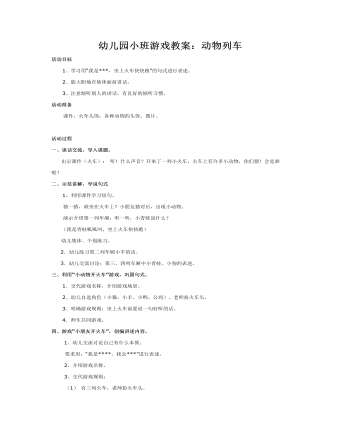
幼儿园小班游戏教案:动物列车
活动准备 课件,火车头饰,各种动物的头饰、图片。 活动过程 一、谈话交流,导入课题。 出示课件(火车):听!什么声音?开来了一列小火车,火车上有许多小动物,你们猜!会是谁呢? 二、示范讲解,学说句式 1、利用课件学习短句。 猜一猜,谁坐在火车上?小朋友猜对后,出现小动物。 演示介绍第一列车厢:听一听,小青蛙说什么? (我是青蛙呱呱叫,坐上火车快快跑) 幼儿集体、个别练习。
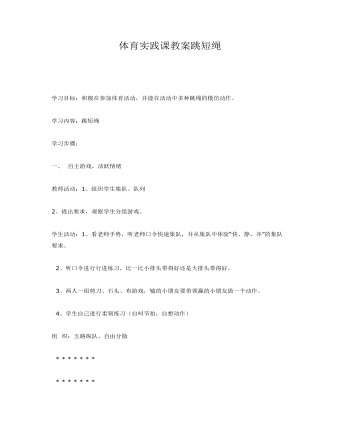
大班体育教案跳短绳课件教案
学习内容:跳短绳学习步骤:一、 自主游戏,活跃情绪教师活动:1、组织学生集队、队列2、提出要求,观察学生分组游戏。学生活动:1、看老师手势,听老师口令快速集队,并从集队中体验“快、静、齐”的集队要求。 2、听口令进行行进练习,比一比小排头带得好还是大排头带得好。 3、两人一组剪刀、石头、布游戏,输的小朋友要带领赢的小朋友做一个动作。 4、学生自己进行柔韧练习(自叫节拍,自想动作)组 织:五路纵队、自由分散 * * * * * * *

大班音乐教案:各种节大奏聚会
活动准备: 1、儿童经验基础:幼儿对节奏感兴趣。 2、材料准备:塑料袋、易拉罐、娃哈哈瓶(内放豆子或沙子)、饮料瓶,筷子、杯子,碟,铁盒子若干、脸盆、碗、、算盘、小板凳,木头积木等生活中的物品;歌曲磁带、录音机 活动过程: 一、让幼儿发现生活中有节奏的声音,初步感受节奏 1、教师示范用发出一些生活中有节奏的声音,让幼儿拍手表现节奏。 ● 牛叫,哞--哞---哞---哞---!”你听到了什么声音?里面藏着什么节奏?我们一起来学学看,“哞---哞---哞---哞---”,你能拍手告诉大家吗?除了拍手你还有什么方法可以表现这种节奏? ● 你们真能干,我这里还有不一样的节奏,你能听出来吗?。(青蛙叫)真有趣,青蛙的叫声也是有节奏的。我们一起学学看,你还可以用什么方法表示“呱 呱 呱呱 呱!”这种节奏呢? ● 同上方法,老师分别发出:小鸡:叽叽叽叽叽叽,母鸡:咯咯咯咯嗒,火车:呜----轰隆隆隆,等声音。你听出了什么节奏?除了用嘴巴说,我们也可以用其他的方法来表现这种节奏。那我们跟着他一起试试! ● 小结:真有趣,我们生活中的许多声音都是有节奏的。有的长,“哒——哒——哒——”,有的短“哒哒哒”,还有的长长短短连在一起,“哒——哒——哒哒哒”,都是不一样的,真有趣。
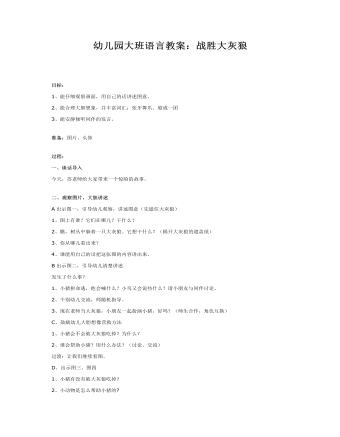
幼儿园大班语言教案:战胜大灰狼
2、能合理大胆想象,并丰富词汇:张牙舞爪、缩成一团3、能安静倾听同伴的发言。准备:图片、头饰过程:一、谈话导入今天,苏老师给大家带来一个惊险的故事。二、观察图片,大胆讲述A出示图一,引导幼儿观察,讲述图意(先遮住大灰狼)1、图上有谁?它们在哪儿?干什么?2、瞧,树丛中躲着一只大灰狼。它想干什么?(揭开大灰狼的遮盖纸)3、你从哪儿看出来?4、谁能用自己的话把这张图的内容讲出来。
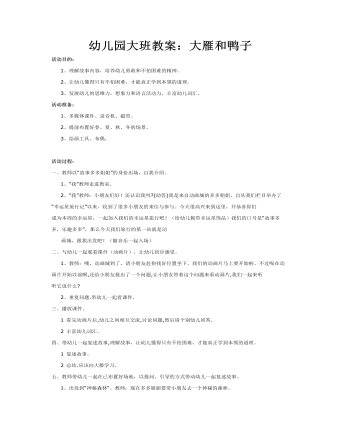
幼儿园大班教案:大雁和鸭子
活动准备: 1、多媒体课件、录音机、磁带。 2、提前布置好春、夏、秋、冬的场景。 3、绘画工具、布偶。 活动过程:一、教师以“故事多多姐姐”的身份出场,自我介绍。 1、“我”教师走进教室. 2、“我”教师:小朋友们好!还认识我吗?(幼答)我是来自动画城的多多姐姐,自从我们栏目举办了“幸运星旅行记”以来,收到了很多小朋友的来信与参与。今天很高兴来到这里,并恭喜你们成为本周的幸运星,一起加入我们的幸运星旅行吧!(给幼儿佩带幸运星饰品)我们的口号是“故事多多,乐趣多多”,那么今天我们旅行的第一站就是动 画城,跟我出发吧!(随音乐一起入场)
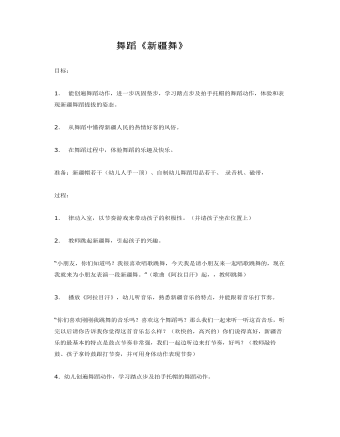
大班音乐教案:新疆舞大班音乐
2. 从舞蹈中懂得新疆人民的热情好客的风俗。3. 在舞蹈过程中,体验舞蹈的乐趣及快乐。准备:新疆帽若干(幼儿人手一顶)、自制幼儿舞蹈用品若干、 录音机、磁带, 过程:1. 律动入室,以节奏游戏来带动孩子的积极性。(并请孩子坐在位置上)2. 教师跳起新疆舞,引起孩子的兴趣。“小朋友,你们知道吗?我很喜欢唱歌跳舞,今天我是请小朋友来一起唱歌跳舞的,现在我就来为小朋友表演一段新疆舞。”(歌曲《阿拉目汗》起,,教师跳舞)3. 播放《阿拉目汗》,幼儿听音乐,熟悉新疆音乐的特点,并能跟着音乐打节奏。
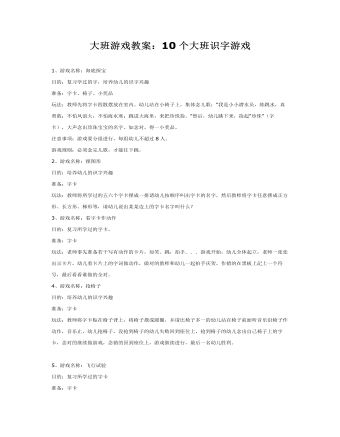
大班游戏教案:10个大班识字游戏
准备:字卡、椅子、小奖品玩法:教师先将字卡四散摆放在室内。幼儿站在小椅子上,集体念儿歌:"我是小小潜水员,练跳水,真勇敢;不怕风浪大,不怕海水寒;跳进大海里,来把珍珠捡。"然后,幼儿跳下来,捡起"珍珠"(字卡),大声念出珍珠宝宝的名字。如念对,得一小奖品。注意事项:游戏要分组进行,每组幼儿不超过8人。游戏规则:必须念完儿歌,才能往下跳。 2、游戏名称:摆图形目的:培养幼儿的识字兴趣准备:字卡玩法:教师将所学过的五六个字卡摆成一排请幼儿按顺序叫出字卡的名字,然后教师将字卡任意摆成正方形、长方形、梯形等,请幼儿说出某某边上的字卡名字叫什么?
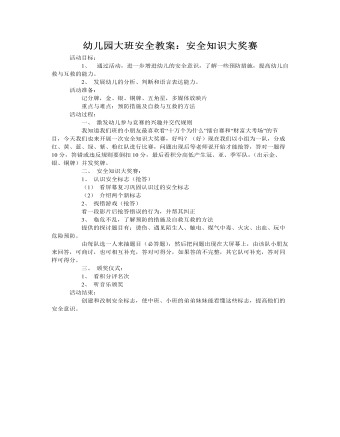
大班安全教案:安全知识大奖赛
活动过程: 一、 激发幼儿参与竞赛的兴趣并交代规则 我知道我们班的小朋友最喜欢看“十万个为什么”擂台赛和“财富大考场”的节目,今天我们也来开展一次安全知识大奖赛,好吗?(好)现在我们以小组为一队,分成红、黄、蓝、绿、紫、粉红队进行比赛,问题出现后等老师说开始才能抢答,答对一题得10分,答错或违反规则要倒扣10分,最后看积分高低产生冠、亚、季军队,(出示金、银、铜牌)并发奖牌。 二、 安全知识大奖赛: 1、 认识安全标志(抢答) (1) 看屏幕复习巩固认识过的安全标志 (2) 介绍两个新标志
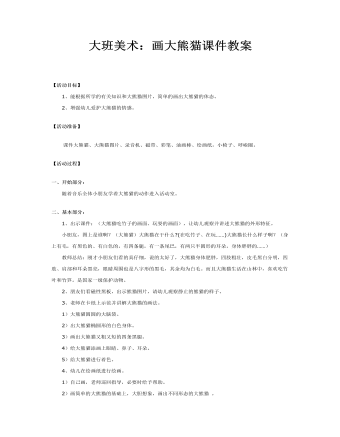
大班美术:画大熊猫课件教案
【活动准备】 课件大熊猫、大熊猫图片、录音机、磁带、彩笔、油画棒、绘画纸,小椅子、呼啦圈。【活动过程】一、开始部分: 随着音乐全体小朋友学着大熊猫的动作进入活动室。二、基本部分:1、出示课件:(大熊猫吃竹子的画面、玩耍的画面),让幼儿观察并讲述大熊猫的外形特征。 小朋友,图上是谁啊?(大熊猫)大熊猫在干什么?(在吃竹子、在玩……)大熊猫长什么样子啊?(身上有毛,有黑色的、有白色的,有四条腿,有一条尾巴,有两只半圆形的耳朵,身体胖胖的……) 教师总结:刚才小朋友们看的真仔细,说的太好了,大熊猫身体肥胖,四肢粗壮,皮毛黑白分明,四肢、肩部和耳朵黑亮,眼睛周围也是八字形的黑毛,其余均为白毛。而且大熊猫生活在山林中,喜欢吃竹叶和竹笋。是国家一级保护动物。2、朋友们看磁性黑板,出示熊猫图片,请幼儿观察静止的熊猫的样子。3、老师在卡纸上示范并讲解大熊猫的画法。1)大熊猫圆圆的大脑袋。2)出大熊猫椭圆形的白色身体。3)画出大熊猫又粗又短的四条黑腿。4)给大熊猫添画上眼睛、鼻子、耳朵。5)给大熊猫进行着色。4、幼儿在绘画纸进行绘画。1)自己画,老师巡回指导,必要时给予帮助。2)画简单的大熊猫的基础上,大胆想象,画出不同形态的大熊猫。3)为大熊猫添画竹笋、竹叶等。4)给大熊猫进行着色。注意画面的整洁,涂色要均匀。

